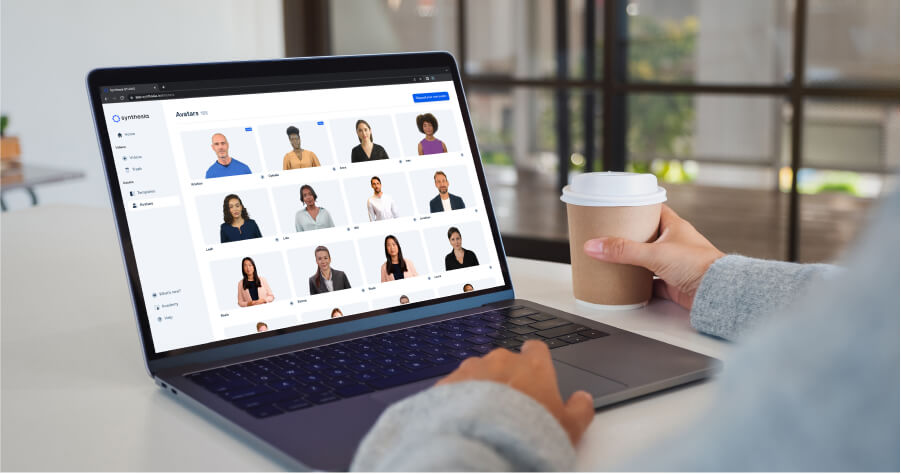
Create AI videos with 230+ avatars in 140+ languages.
Of all video content online, how-to videos are the most widely watched across all ages and countries. And their popularity isn’t limited to just YouTube videos…
… In 2022, just under 50% of internet users watched a how-to or tutorial video every week.
That means your share of billions of views is up for grabs. All you need is a helpful and engaging how-to video to share.

Learning how to make how-to videos is super easy. Forget the days of edit suites and expensive productions; technology has got your back.
This post will dig into all the ins and outs of what a how-to video is, how it's used, and how you can make your own how-to video in the next few hours.
What exactly is a how-to video?
How-to videos (also referred to as tutorial videos or instructional videos) exist to teach leads, users, or customers a concept or skill. How-tos are most effective when you want to teach complex information in a step-by-step process.
How-to videos are so popular and prolific on the internet that you’ve likely watched one in the last week!
Enterprises, small-medium businesses, and startups all use how-to videos to better connect with their customers and communicate in a clear and concise manner. For businesses, a tutorial video is an incredibly versatile format and can be used for marketing and educational applications.
Who creates video tutorials and how-to videos?
How-to videos can be a great way to increase someone’s attention span. With a longer attention span, you can better showcase the function and benefits of your products and services.
Many find how-to videos a surefire way to improve conversion and retention rates on their website:
- Startups, and SaaS companies use how-tos to quickly teach their customers how to use their products in the most efficient way possible.
- Companies with a physical product might use how-tos to teach customers how to set up their products.
- Independent content creators use how-tos to build an audience around their skills and knowledge on platforms like YouTube.
Why do companies create how-to videos? What’s the real benefit?
Why create tutorial video content?
A tutorial video is a quick way to show potential or current customers how your product works. It goes a step further than a demo, as you’re not just showing what it looks like; you’re also teaching the watcher to repeat the steps when they use the product themselves.
When making tutorial videos, pay attention to the learning objectives, the step-by-step flow from A to Z, and possible troubleshooting solutions. Check out the example below to see what a how-to video tutorial looks like in action.
Why create product marketing & sales video content?
Creating how-to videos optimized for sales have great potential to reach prospects and build relationships. They’re like an upgraded elevator pitch for how a customer might use your product in real life. It's a great choice when launching a crowdfunding campaign or punting new services and products.
Consider these three factors when making a how-to video for sales:
- The hook that drove them here.
- The problem they want to solve.
- How your solution will improve their lives.
Why create onboarding how-to video content?
Onboarding how-to videos are a series of short how-to videos designed to quickly bring people up to speed with products or services they’ve just started using. They are an effective educational tool to help new customers realize value faster.
Creating an instructional video for onboarding works is similar to compiling a list of FAQs. Check what questions new users send your support desk and start building a plan from there. For in-app onboarding, consider making bite-size videos with only the necessary information instead of one long video.
Check out the example below to see what an onboarding how-to video looks like in action.
Why create general instructional video content?
Instructional videos are educational videos that take traditional presentations to the next level. Think lecture material, online courses, or screencasting tutorial videos.
These how-to videos allow the user to follow the presenter’s process step-by-step at their own leisure. Instructional videos will visually communicate to the audience how to navigate through a problem to a solution and learners will often refer back to them when stuck.
Many businesses also optimize their video title and description for search engines when creating instructional videos.
The 4 different styles of how-to videos
There are four main styles of how-to videos for your audience and users. You can mix and match if needed or stick to the one that suits your topic best.
1. Live-action how-to or explainer videos
Live-action videos are expensive and timely to make. They employ a physical set/studio and live human actors. Usually, you’ll need to outsource this video to a post-production house. Live-action is most suited to companies with a physical product or sophisticated businesses which have achieved profitability or funding.

2. AI-generated videos:
Auto-generated videos are made using a script and AI video maker. A computer can generate both the voice-over and the explaining avatar. Not only is this fast and easy to create, but it also makes updating outdated sections fast and easy.
For example, if a product feature changes and you need to adjust your script, there’s no need to hire the same actors and reshoot. All you have to do is duplicate your video, click edit, copy-paste your updated script, and click “Generate.”
Pure simplicity 😇

3. Over-the-shoulder tutorial videos
Over-the-shoulder tutorials are when someone records their screen and walks you through a task step-by-step. Almost like you’re looking over their shoulder at their screen as they teach you how to do something.
Making these kinds of video tutorials is low-effort as they follow a rough plan and explain how to do a complex task via screencast. It’s ideal when you need to explain how to use a product or software features.
To make the video recording more professional, you can use audio narration over your screen capture, edit your video with graphic intros, and add a background audio track.

4. Animated how-to videos
Animated how-tos are made using a simple 2D vector style of art. They’re easier to make than live-action videos, as you don’t need to hire a set, actors, or camera equipment. These make great sales videos and help explain a complex concept. Animated how-tos do well on social media platforms but don’t often rank as youtube videos or for keywords with high search volume.

The easiest way to create a great how-to video
How you create your video depends on what you need to explain. Here are a few tips and tricks that can greatly speed up the entire process.
Before you begin step one, take a moment to answer the following:
- Where will this video live on your website/user interface?
- What mindset will watchers have when they watch this video? What do they already know, and what have they never heard of?
- What’s your end goal? What mindset/skill should the watcher confidently walk away with?
When you’ve answered those questions, you’ll find the rest comes easy.
Step 1: Write your video script
Writing a short brief is a great way to visualize what you want to communicate. We recommend you keep your videos short and informative (especially for social media).
Typically, videos that explain a concept are around 90 seconds. A screen recording tutorial or step-by-step how to can be anywhere from 5 minutes to an hour long. You can also create microlearning videos which are great for posting on social media.
Step 2: Explore editing software
When you know what’s out there, it’s easy to decide on the right video editing software and the style of video you will create.
Some editors, like Synthesia, come with all-in-one filming, scripting, and editing capabilities.
Others, such as Adobe Premier, require in-depth knowledge and technical skill to create a good video. Whatever option you choose, ensure your video is not covered with the watermark of your editing program as this may distract viewers.
Step 3: Choose a video template
Templates for making how-to videos can greatly speed up your production process and improve the consistency of your video branding.
A good video template should be intuitive to edit and provide you with easy-to-follow timing suggestions.
Step 4: Record video, voice-over, and screencasts
To create high quality videos, you or your actor have all the equipment capable of making instructional videos with good lighting, a neutral backdrop, and high-quality sound. In the case of a video tutorial, a screen recording can add great value to an explainer video.
Be careful to record using the highest-quality settings. Your viewers won’t learn anything if they can’t see or hear you properly.
Step 5: Export and publish
Double-check that the file is saved in your desired frame rate and aspect ratio. Make sure the file size and file type are compatible with the platform where the instructional video will be hosted, such as YouTube or Vimeo.
4 Common mistakes people make when learning how to create how-to videos
Watching a how-to video can be helpful… or frustrating. And sometimes both. 🤦
Here are things to avoid when creating a video tutorial:
1. Your how-to video is too long
Focus on the essential steps, and don’t spend too much time on fancy animations that don’t convey much information. It’s all about packing in as much know-how into as little time as possible.
2. Your video tutorial steps are too vague
Be specific in your video tutorial. Show realistic examples where possible — especially when the user might need to do some troubleshooting to progress.
3. There are distracting elements in your video
As the saying goes, keep it simple, silly 😜.
Your transitions, graphics, and screen recordings should draw in the viewer, not distract them.
4. Your overall sound quality is poor
Don’t skimp on the quality of your audio. Background music shouldn’t be too loud, and spoken voiceovers should be clear, with the message delivered in a positive, calm voice that is neither too slow nor too fast.
How will AI speed up the creation of a how-to video?
Video creation and editing get expensive and time-consuming fast. If you want to know how to make a how-to video faster (and more cost-effective), hold onto your socks because AI has the ultimate answer:
In the next five minutes, you can input a script into software and generate a fully realistic AI avatar complete with a natural-sounding voice over.
Adjust a few finer points, throw in extra elements like a screencast, and you’re ready to go.
To do this, you can use a tool like Synthesia. Click play to watch a video on how to make how-to videos that was made with AI.
How AI can help you make a how-to video
We’ll be the first to admit that “AI” or Artificial Intelligence is a big word that’s a bit tricky to understand. Here’s a breakdown of how businesses are using this technology on a day-to-day basis.
Text-to-speech
An AI voice generator will turn written text into a professional voice-over that’s ready to go. This removes the need for voice actors and microphones and ensures your sound quality is always consistent.
Generated AI presenters
You can quickly generate a talking head video with no equipment — not even an actor. By recording real people, AI can create a digital twin of a real actor or person.
Combined with text-to-speech technology, an AI video maker can create a realistic human-like avatar that talks and moves naturally.
Translation
No more manual video translation or dubbing. Audiences worldwide can now watch videos and tutorials in their own language thanks to translation capabilities.
Scriptwriting
With advanced OpenAI GPT-3 AI algorithms you can generate a video script with just one click.
Get started on your own how-to video
Instructional videos and video tutorials don’t have to take months to create.
By setting your goals, developing a clear script, and using the right tools, you can create videos for your brand quickly and easily. Get started by making a free AI video with Synthesia.
About the author
Learning Strategist & Speaker
Elly Henriksen
Elly Henriksen is a accomplished instructional designer exploring the impact of AI-generated content on learning design. With eight years of experience across both professional and higher education institutions, notably The University of Washington, Elly provides an insightful perspective on the transformative power of synthetic media for learners and instructional designer. Her versatile roles, from course facilitator to eLearning author and LMS administrator, give her a unique vantage point on the evolving trends in instructional design and how AI impacts the learning landscape. Explore Elly's insights and her pursuit of leveraging AI to redefine the future of the learning world.















